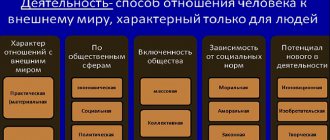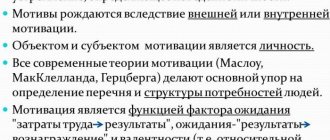Man is an active being. Actually, purposeful activity distinguishes a person from an animal. More precisely, animals also carry out certain types of activities, but most of them are unconscious and are aimed at satisfying the most basic individual needs.
Human activity is connected with his social essence. Indeed, many of the actions of modern man are aimed at maintaining a certain state of society, its development and improvement, and not at satisfying one’s physiological needs. Most of the population of developed countries devotes their lives to activities in such areas as science, art, social activities, entertainment and games, and communication. On the other hand, in many developing countries, “lower-level” activities prevail: obtaining food, ensuring personal safety, etc. The social component in such activities is not so important, so any social norms may not be observed: crime, wild morals and orders, extreme individualism, a distant and suspicious attitude towards others. It follows from this that various types of human activity were formed in the process of its evolutionary and socio-historical development.
Indeed, there was a time when many professions and occupations characteristic of modern society did not exist at all. Only relatively recently (by historical standards), for example, scientists emerged from the entire mass of people - figures who professionally study the world around us and how to influence it. Even later, theoretical and practical science and various scientific disciplines separated: thus, the early ancient Greek philosophers were involved in literally everything - geometry, medicine, and astronomy, they talked about the nature of the universe and invented mechanisms. The gradual complication of scientific knowledge led to a peculiar division of intellectual labor.
What is an activity
Under activity
It is customary to understand the process of active interaction between a subject and an object of reality, in which the subject purposefully influences the object, achieving a goal and satisfying its needs.
Activities can be either constructive or destructive. Often both components are present, since often in order to create something, you need to destroy something first, and vice versa (for example, create a weapon to destroy the enemy army). The activity of a person or organization can be called any activity that is given a certain meaning - that is, the activity is somehow connected with the external world or the internal state of a person or organization.
Of particular importance for humans and animals is orientation-research activity, which became more and more diverse with the evolutionary complexity of organisms. This activity allows animals to survive, leave offspring and generally follow certain instincts, practically interacting with the outside world. Human activity is of a different nature, since the instincts in his psyche are abolished and in his life he is guided by the intellect.
Means to achieve the goal
So, I see the goal. I'm going to see her. At this stage we choose the means to achieve what we want. By means here we mean anything - anything that will help you achieve your goal. If you want to become a good cook, you will have to graduate from culinary school, gain experience, and constantly improve your skills by learning new skills.
It is important to know: firstly, the means and the end must be proportionate . For example, you want to make money, you open a personal business (flower shop), but in the end your enterprise operates at a loss. A reasonable person understands that in this way he will never improve his well-being and will try something else - the means will not justify the end.
Secondly, the means must be in the moral category . If this is not so, then all human activity is immoral. Violating the law, lying to achieve personal gain, betraying loved ones for the sake of your goal is immoral. In this case, the end does not justify the means.
Structure and nature of activities
Unlike animal behavior, human conscious activity has a certain structure.
Various human activities consist of several stages
:
- Decision making process.
- Involvement in activities.
- Goal setting.
- Designing an action program.
- Implementation of the action program.
- Analyzing the results of actions and comparing them with the goals set.
In the process of his activity, a person becomes aware of himself and his actions, compares his needs with his capabilities and, in accordance with this, builds a program of action. As new knowledge and experience is gained, the action program can be adjusted and changed. All these components are absent in animal behavior: for example, a cat will try to climb a tree even if its claws have been cut off. The instinctive nature of animal activity can be illustrated by one well-known example: a rooster, whose head was cut off, but kept alive by artificially introducing food, tried to peck grain, crow and perform other actions characteristic of his “healthy” brothers. The brain was not needed in his life (only the cervical region of the brain was preserved).
Action
An action is a single element of activity.
The latter consists of a set of small steps interconnected. For example, to build a house, you first need to dig a foundation, build walls and a roof, and pour the floor.
Sociologist M. Weber identified 4 types of social actions :
- goal-oriented – striving to achieve a reasonable goal (preparing a speech before a speech);
- value-rational – focused on moral values (a soldier’s refusal to give up his country’s military secrets);
- affective - actions committed under the influence of feelings and emotions (a person in a rage can break something);
- traditional - habitual actions, rituals, customs (throwing a wedding bouquet into a crowd of bridesmaids, fireworks for the New Year);
The first two types underlie activity, the second two appear partially and are of an auxiliary nature.
Forms of human activity
There are a lot of types of human activity, and they are all divided into two categories: practical (material) and spiritual.
Material and practical activity has the goal of changing the world around us. And since this world consists of nature and society, practical activity can be either production (changing nature) or social-transformative (changing the structure of society).
Spiritual activity is aimed at changing public or individual consciousness. It includes science, art, the organization of collective life, and also religion. The goals facing spiritual activity are knowledge, determining life values, creating models of the future (forecasting), etc.
There are, however, no clear boundaries between material-practical and spiritual activity. This is a conditional division, and in reality, the spiritual and material aspects of our lives are inextricably linked with each other. Any human activity has a material side, since it is aimed at interacting with the outside world and uses certain material means, and a spiritual side, since it involves goal setting, creating a program of action, evaluating the results of actions, etc.
Knowledge, abilities, skills, habits
Knowledge, abilities, skills, or KUN – the basis responsible for organizing and managing practical activities.
Knowledge
These are images of sensations and perceptions, later processed into ideas and concepts. Without them, conscious, purposeful activity is impossible. Knowledge increases the effectiveness of actions.
Skills
This is mastery of a method of performing an action that does not require reinforcement with exercises. Conscious individual control is the main difference between skills. They are closely related to thinking and are impossible without active intellectual activity. Skills allow you to find a way out of non-standard situations and respond to changes in external conditions.
Skills
Skills are actions brought to automaticity. The success of an activity depends on skills. Skills are formed through exercise - repeated repetition of a specific action (actions). The skill is based on a dynamic stereotype, that is, a neural connection between the elements of the action. This happens uncontrollably, but if any inaccuracy occurs, the person immediately notices it. The stronger the nerve connection, the faster and better the action.
Skills can be motor, thinking, sensory, behavioral. The skill is formed in several stages:
- introductory (comprehension of actions, familiarization with implementation techniques);
- preparatory (conscious but inept execution of an action);
- standardizing (unity and automaticity of actions);
- situational (mastery of arbitrariness of action).
Learning new skills is always influenced by old ones. Sometimes this helps, and sometimes it hinders. In the first case we are talking about coordination of skills, in the second – about interference (contradiction). Skills are aligned when:
- the movement system of one skill coincides with the movement system of another;
- one skill is a means of better mastering another;
- the end of one skill is the beginning of another and vice versa.
Accordingly, interference occurs under the opposite conditions.
Habits
A habit is an action that has become a need. Habits can be positive and negative. Habits, like skills, are based on dynamic stereotypes. Habits are formed through:
- imitation;
- multiple random repetitions;
- conscious, goal-directed learning.
They can be a driving force or a braking factor when performing an activity.
Types of human activities
The time has come to understand the main types of human activity.
Work
This is the main type of human activity, to which several others are subordinated. Labor is usually understood as the creation of products useful to society that satisfy the material or spiritual needs of people. In the process of work, a person changes reality, using certain means and methods for this.
The concept of labor has had slightly different meanings at different times. Until relatively recently, this word meant mainly physical activity, while intellectual activity was considered useless. In our time, central importance is attached to intellectual (scientific, creative) activity, since society needs its results most of all; but physical activity turns out to be increasingly unprofitable, since automation does such work better than a person, and consumes fewer resources, so the concept of “labor” for such activity is becoming less and less correct.
It is believed that it was labor, along with speech, that became the factor that predetermined the transformation of an animal into a human. In fact, this is not entirely true, since an exclusively human type of activity, which has no analogues or prototypes in the animal world, is only creativity.
Teaching
This is the process of systematically acquiring knowledge, skills, and abilities that are necessary in work. Teaching emerged as a special type of human activity when the amount of knowledge accumulated by humanity became very large; In order to assimilate this knowledge, a significant amount of time and resources became necessary.
A game
This is a human activity that is not aimed at creating any material product. During the game, a person (most often a child) learns certain social norms and learns to live in society. In childhood, play is developmental in nature, and in adulthood it becomes a means of relaxation and communication.
The game involves activity in conditional situations that simplify real ones. During the game, a person practices actions and scenarios that will then be used in “real” life. Games are found not only in humans, but also in many animals, and the more complex they are, the more complex the games. In higher animals, especially monkeys, manipulative games involving the use of objects are observed.
Communication
An activity consisting of interaction between two or more people for the purpose of exchanging information. This information can be not only cognitive, but also affective and evaluative. Communication also exists in many animals, especially social ones. Thus, bees use special body language to tell each other where the food is.
The emergence of communication is associated with the complication of life activity, being in conditions that impede the individual survival of the organism. Under such conditions, division of labor became necessary, which is also observed in social animals. Communication allows group members to coordinate their actions and achieve a common result.
Creation
This is the highest level of human life. Creativity is inherent only to people. Outwardly, it resembles ordinary labor activity, but the essence of creativity is fundamentally different.
Creativity is the creation of fundamentally new things, objects, spiritual values. The main criteria in creativity are the uniqueness of the product and its social benefit.
For the first time, ancient thinkers began to distinguish between work and creativity. According to Aristotle, labor is carried out due to the necessity of life (the need for food, clothing, shelter), as well as by someone’s order; creativity is a free act that does not have a purely utilitarian meaning. Oddly enough, slavery helped ancient philosophers realize this: the daily actions of a slave and a free person are significantly different. Of course, in those days the Greeks also had educated and creatively gifted slaves, whose masters gave them more freedom; Ultimately, such slaves were released, and many of them subsequently became prominent individuals.
It was much more difficult for the inhabitants of Ancient Rome, who were more simple-minded and lived in harsher conditions, to understand the meaning of creativity. The Romans did not have “learned slaves” for a long time (the fashion for them came much later from Greece), and all Roman slaves were kept in equally strict conditions. Slaves and free citizens in Rome differed from each other mainly in the list of available professions, and not in the ability or impossibility of “creating.” For a long time, all art and theoretical science in Rome were direct borrowings from the Greeks and Etruscans.
This distinction between types of human activity, however, is not rigid. All of them can be combined with each other. For example, educational activities are very often carried out in the form of a game, and “ordinary” work is combined with creative activity.
Main spheres of society's life
Any type of human activity (work, play, communication, etc.) can take place in any area.
There are traditionally four such areas:
:
- Social
– peoples, classes, gender and age groups, etc. - Economic
– production relations, productive forces. - Political
– the state, parties, socio-political organizations. - Spiritual
- religion, morality, education, art, science.
In this case, each person is affected simultaneously by all four spheres. Each of us belongs to a certain nation, social class, has a certain age and gender, enters into economic relations, has a certain level of education and a certain worldview.
However, not all types of human activity in each of the spheres are equivalent. Thus, in the spiritual sphere, science occupies a dominant position, its “reflections” are education and art; morality depends on the level of collective awareness of society, and religion is a consequence of an extremely low level of this same awareness. The nature of social activity can change over time: in one era the average person can work for the prosperity of his nation, in another his work can be aimed at meeting the needs of all humanity as a whole, because there is no division into peoples and nations.
Characteristics
Experts identify the following four main features of human activity, which determine its specificity and characteristics:
- Consciousness , since a person consciously sets a specific goal for his own activity and determines ways to achieve it.
- Productivity (activity always leads to the individual obtaining the final result he planned at the beginning of the activity).
- Transformation , i.e. people changing the surrounding reality or themselves.
- Social character , due to the entry of an individual in the process of activity into various relationships with other individuals.
Examples of human activity
It would seem that an active person is immediately visible. He can build houses, heal people, paint pictures, give lectures. We are accustomed to distinguishing an “active” from an “inactive” person by the presence of any benefit in his actions. But as a rule, by benefit we often understand only our own benefit or the benefit for those on whom we are dependent: we consider engaging in “state affairs” useful, although most often only civil servants benefit from them; in the same way, the serf once considered useful activities that satisfied the desires of his master.
We often call children who play too hard (often they can also be adults) slackers, although in reality this is incorrect. The game can bring enormous benefits to the players themselves, helping them develop some important knowledge and skills; and this, in turn, can further benefit others.
Thus, some specific human activity may not bring immediate benefit, but without it the existence of all mankind can be greatly complicated in the future. Let's imagine a primitive man who amused himself by throwing pieces of clay into a lighted fire. It would seem that he is doing sheer nonsense, instead of fulfilling the tasks of providing his tribe with food supplies and other necessary things. However, this “loafer”, with the help of his entertainment, discovered the basics of the production of dishes, bricks, tools, powerful weapons and other things that we cannot do without even in our time.
Sometimes the motives of a person’s life are hidden from the eyes of the observer and do not correspond to external manifestations. There are cases when overweight people came to work at a brick factory to lose weight. The parable of three people who moved stones is widely known; when they were asked what they were doing, the first answered: “I’m hunching over,” the second, “I’m making money,” and the third, looking up at the sky, said, “I’m building a temple.” Outwardly, they were doing the same work, but the ultimate goal of these actions was different for each of them.
Even a person engaged in “imitation of vigorous activity” is still active, because his actions have a very definite meaning (usually this is hiding from his superiors his incompetence, fundamental reluctance to do this work, or laziness).
Currently, information is an extremely important type of human activity. Substantial financial and material resources are being invested in various occupations of this kind, while funding for many other professions is decreasing. However, the real significance of “information” professions is not the same: obtaining and publishing scientific knowledge, for example, has a pronounced social significance, but the production of advertising is mainly aimed only at obtaining personal gain. The production of useful information is adjacent to the production of “information noise”.











